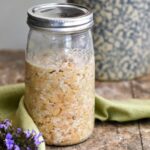How to Make Miso
Homemade miso is so delicious that you will want to eat it straight from the jar with a spoon! While it takes a long time to ferment, the process itself is actually very simple.
- Prep Time: 20 minutes
- Cook Time: 2 hours
- Total Time: 2 hours 20 minutes
- Yield: 1 quart jar 1x
- Category: Condiment
- Method: Fermented
- Cuisine: Japanese
- Diet: Vegan
Ingredients
Units
Scale
- 2 cups dried soybeans
- 2 cups koji rice or koji barley
- 1/2 cup sea salt (non-iodized)
- 1 Tbsp mature fermented miso (optional – see notes)
- 1 tsp of sea salt (not mixed into the ferment)
Instructions
- If this is your first time making miso, see the sections above for details on the right type of container, how to vary the recipe, and other tips.
- Soak the soybeans in 4 cups of water for at least 8 hours or overnight. Drain the water then put the soybeans into a pot with 4 more cups of water. Bring the water to a boil, reduce the heat, and simmer until the soybeans are soft, about 2 hours.
- Drain the beans, reserving 1 1/2 cups of the cooking water. Leave the soybeans and the reserved cooking water to cool to room temperature.
- When the beans are cooled, place them in a large mixing bowl with the koji rice, 1/2 cup of salt, and the reserved cooking water. (I have a video showing all the steps to making miso in the section above).
- Mash everything together by hand or with a potato masher. You want the rough texture of hand mashing, so don’t be afraid to get your hands dirty. Pack the mashed beans and rice into a jar or crock. I typically divide the mixture between two 1-quart jars. Make sure you have at least 1 inch of the headroom at the top of the jar because the miso will bubble up during the fermentation.
- Sprinkle another teaspoon of salt on top of the pack of beans and rice. Cover the miso with a piece of parchment paper or plastic wrap.
- Use a weight to keep everything weighed down during fermentation. It will slowly produce a layer of dark brown liquid called tamari. This can be drained off after fermenting to be used like soy sauce. (Yum!)
- Place the fermentation container in a cool, dark location to ferment for 3-24 months. A basement or closet is perfect.
- Store the miso in the fridge once you start using it. It should last for several years.
Notes
- The secret to ensuring that everything ferments nicely is to sanitize the fermentation container(s) prior to use. I usually fill them with boiling water which is enough to kill any surface bacteria and mold.
- Miso is a mold, yeast, and bacterial ferment. Adding a bit of mature miso provides the necessary yeast and bacterial culture. When making your first batch, it’s fine to use store-bought miso. Look for brands that are refrigerated as they will be unpasteurized and alive. If you can’t find raw store-bought miso, then it’s fine to skip that step. The bacteria and yeast should naturally find their way into your miso.
- Want to get deep into the world for fermenting? Try making your own koji rice!
Find it online: https://www.fermentingforfoodies.com/homemade-miso/
